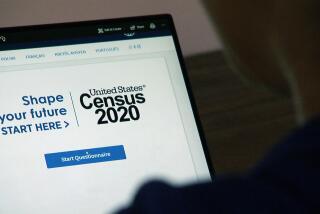We Can’t Count on a ‘Sampled’ Census
- Share via
In 1990, U.S. census takers walked door to door in neighborhoods across the nation performing a crucial mission entrusted to them by the U.S. Constitution: an “actual enumeration” of the population to be conducted every 10 years.
The constitutional language chosen by the founders could not be more explicit. There is no euphemism for the word “enumeration”--it means “to count,” according to Webster’s New World Dictionary.
But Democrats, led by President Clinton, believe they can gain a political advantage in the 2000 census by changing the method outlined in the Constitution. Rather than actually count each person, they will settle for 90% of the population. The other 10% will be accounted for through a technique known as sampling.
The Democrats argue that sampling is necessary to the proper representation of minorities. In 1990, researchers found that African Americans, Latinos, rural residents, recent immigrants and young singles figured heavily into the census undercount.
But sampling will effectively “miss” at least 10% of the entire population. After 90% of the homes in a census tract are counted, the bureau will contact 1 in 10 of the remaining addresses and use the results to estimate, and therefore generalize, the people it could not reach. Sampling makes the dangerous assumption that Americans can be categorized based on where they live.
In 1957, Congress signed a law into statute that allowed for the use of sampling except for the purposes of apportionment (U.S. Code, Title 13, Section 195). In other words: Sampling may be an effective scientific technique in some cases, but for apportionment we must rely on good old-fashioned counting.
The Democrats argue that sampling will bring states a windfall of federal funding due to previous undercounts. Sampling is already used for federal funds allocation, and it is updated every year.
The “enumeration” census method is not perfect. Some areas are hard to find, some are dangerous and some are difficult to access. Everyone concedes that there is a gap between the number of Americans counted and those who actually exist--a 1.8% difference, according to the National Research Council.
But sampling would create a “virtual population” and force government to make decisions based on nonexistent people. While these phantoms will be added to the census counts in some areas, they will be subtracted from other areas. This will result in major population shifts favoring large cities at the expense of suburbs and rural areas.
If the Democrats are so convinced that those missed by the census would vote Democratic, they should focus outreach efforts--and their money--into these areas. Billions of taxpayers’ dollars should not be spent on an experimental method which is inaccurate at best, and could potentially cause a nightmare miscalculation during the 2000 census.


